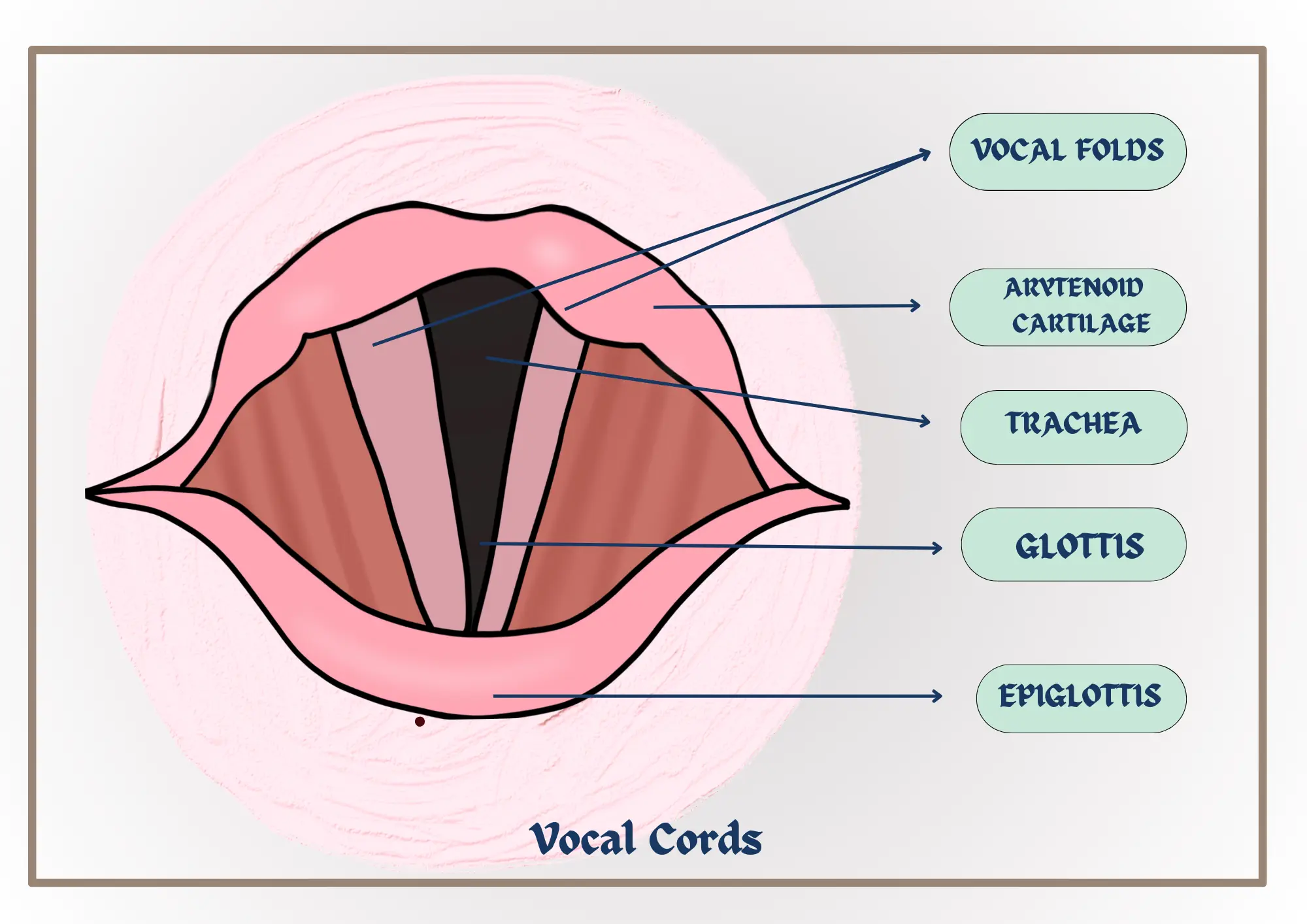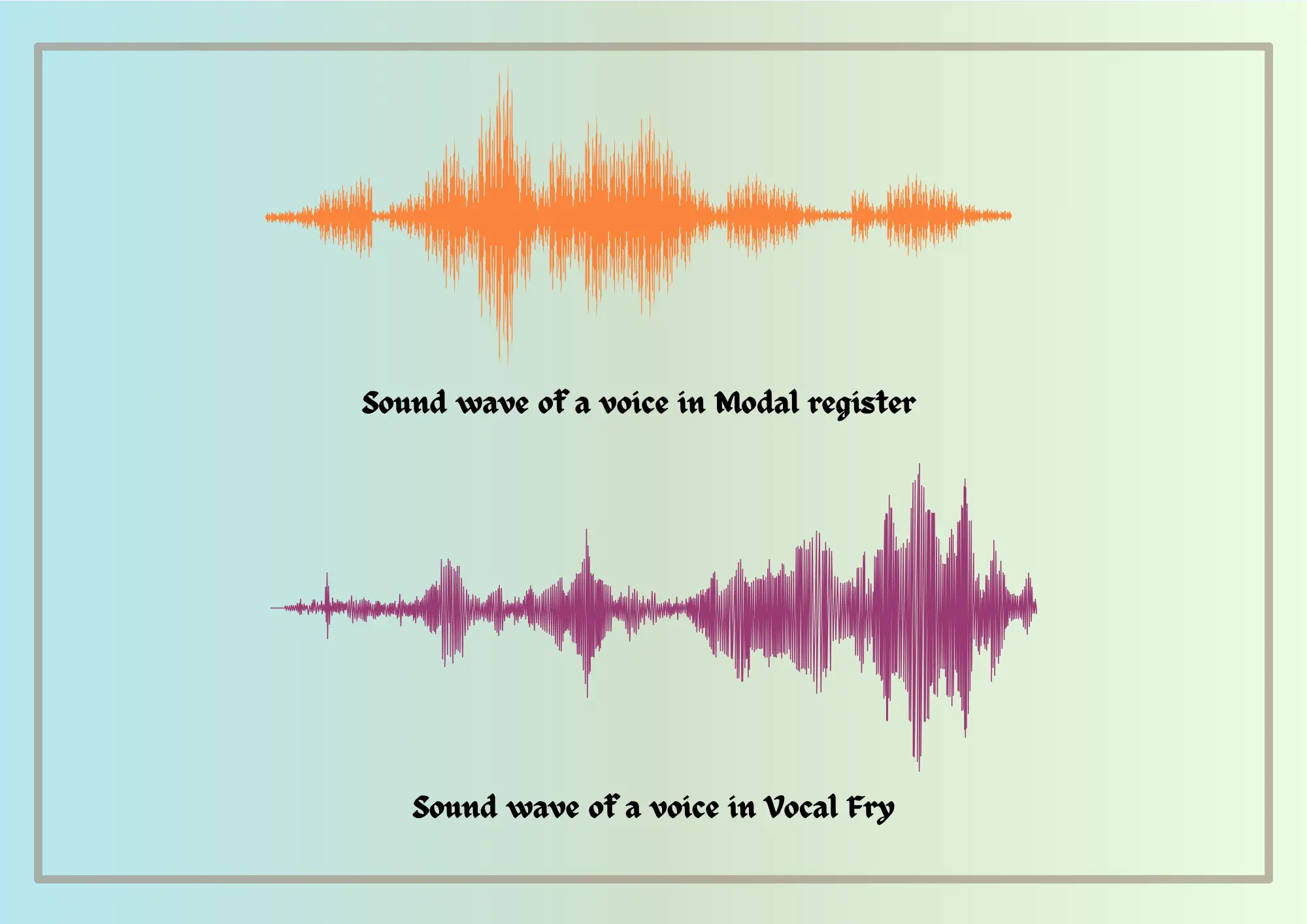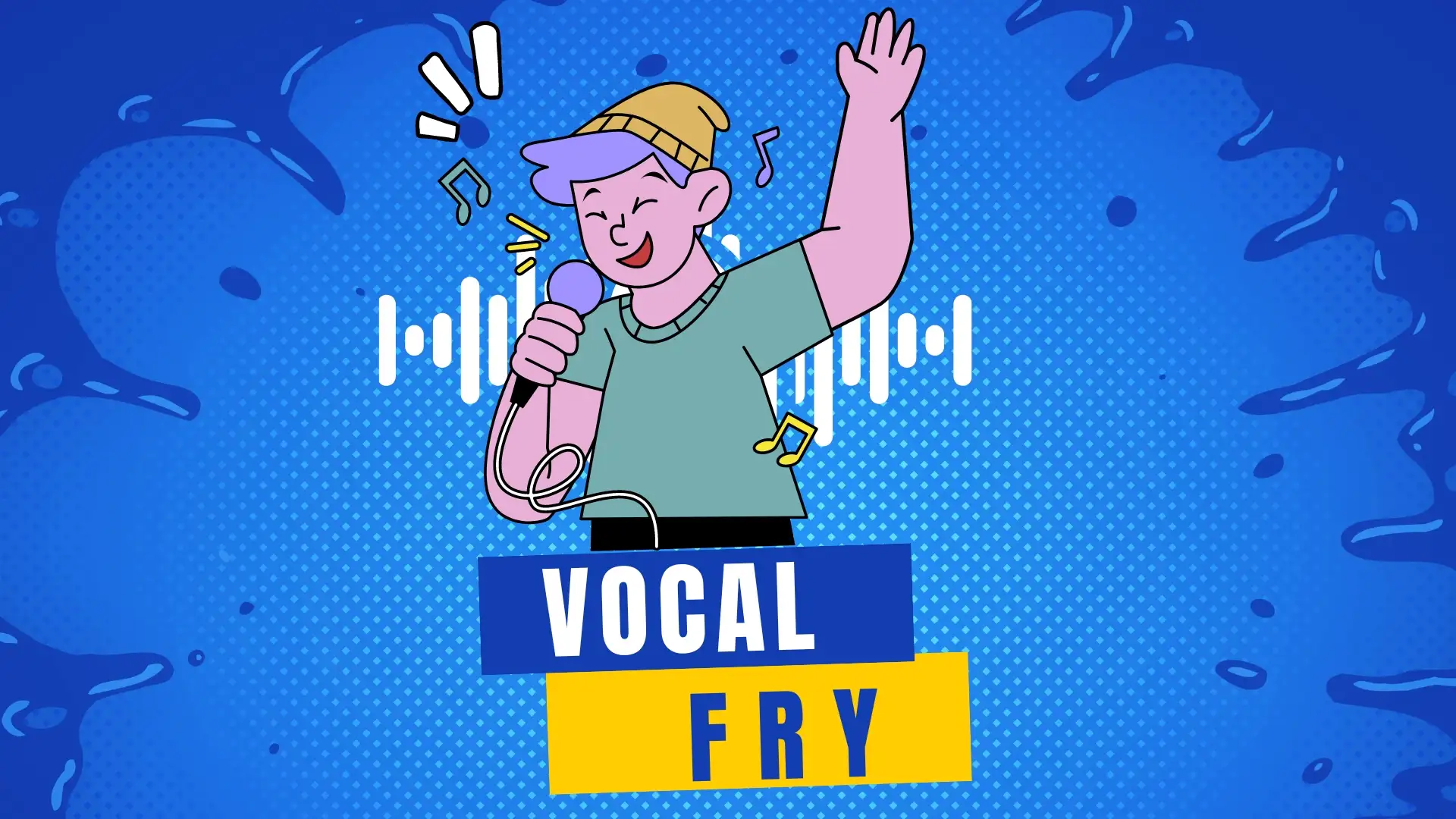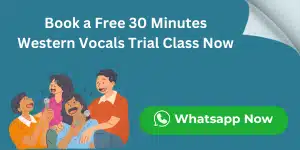- Vocal Fry Definition
- How does Vocal Fry sound?
- What actually happens inside your body?
- Vocal Fry and Gender
- What are the voice registers?
- Little into history of Vocal fry
- Vocal Fry Examples in singing!
- Vocal fry in Speaking!
- What are the Vocal Fry Examples?
- Why should one try vocal fry?
- Is Vocal Fry harmful?
- Closing Thoughts!
- FAQs
In some music genres, vocal fry in singing is used as an ornament to express radiancy and intensity. An important point to note is excessive usage of vocal fry in singing will tamper the health of vocal cords.
Let’s look into it’s definition, Examples, and gender related deets and impact on voice in this blog.
Vocal Fry Definition
One of a definition is the lowest vocal register of your voice. It is the physical shortening of the vocal folds that results in a full closure and subsequent pop back up to create a sizzling or frying sound.
Some people can naturally use Vocal Fry in Singing the lower pitch, while others may choose to switch to the lower range on and off at any moment. Some people say that it could indicate Medical issues.

Did You Know?
Glottal scrape, Creaky Voice, Pulse Register, Pulse Phonation, Creak, Croak, Glottal Fry, Glottal Rattle are some of the other names of Vocal Fry.
How does Vocal Fry sound?
The sound of it caused by air moving through the vocal folds unevenly, and it sounds like cracking, rattling, and popping. It sounds low-pitched and has kind of a deep tone.
What actually happens inside your body?
The vocal folds compress rather firmly and become somewhat slack and compact during this phonation due to the arytenoid cartilages of the larynx being pulled together. When air flows through the glottal closure, this process creates a huge, irregularly vibrating mass inside the vocal folds that gives rise to the distinctive low popping or rattling sound.
Vocal Fry and Gender
It is used in singing and while speaking by both men and women. The primary differences between it’s impact on men and women in voice is still yet to be discovered. Although, there isn’t so much distinction physically between the both the genders. Men and Women let their vocal cords vibrate by shortening it to produce the creaky noise.
We also know that young girls uses it while speaking, rather than males or older women.
What are the voice registers?
Voice registers refers to the series of tones produced by the human voice due to the vibration of the vocal folds. Voice registers originate from laryngeal function. The reason they happen is that the vocal folds have several vibratory patterns that they may produce. Each of these vibratory patterns generates distinct sounds and appears within a certain pitch range.
We have got,

Whistle Register
The highest range of the human voice is the whistling register. Because the notes generated by this range have a tone similar to a whistle, it is known as the whistling register.
Falsetto Register
The falsetto register overlaps the modal register by about one octave and is located above the modal voice register.
Modal Register
Most of our speaking and singing are done in the modal voice, which is the standard register for both. The vocal folds in this register elongate, become more tight, and have thinner edges as pitch rises.
Vocal Fry Register
The lowest vocal register, known as the vocal fry register, is created by a lax glottal closure that allows air to burst through and generate an extremely low frequency popping or rattling sound.
Little into history of Vocal fry
Though its distinctive sound was identified far earlier, the vocal fry register and communication in American English has only recently become a recognized and recognizable register. Vocal music educators did not become familiar with this term until the early 1970s, when it was first brought up in the context of phonetics and speech therapy.
Similar to other vocal registers, this is characterized by a distinct vocal fold vibratory pattern, a particular set of pitches, and a particular kind of sound.
How does Vocal fry work?
The air in your lungs rises into your throat and reaches your vocal cords when you sing or talk. The vocal cords cut up the air by opening and closing hundreds or thousands of times each second.
Your throat, mouth, teeth, and tongue influence the vibrations produced by the opening and shutting of the cords. We can hear your voice as well.
Now, the vocal cords vibrate somewhat differently in each vocal range. Additionally, this alters the tone of your voice.

Vocal Fry Examples in singing!
Recall some singers starting to sing the phrases of a song with a creaky sound and then switching to Modal Register. Best example of this will be male country singers.
This should glow bright as a light bulb, the opening line of Britney Spears’ song “…Baby One More Time” is among the most famous and known examples. Anybody can sing “oh baby, baby” in a Britney impersonation, but it won’t be complete without a lot of vocal fry.
Most of the time in choirs, we can find the bass singers vocally fry their bass notes rather than singing in it. You can easily find the effect of vocal through this song.
Growling in the Metal genre could be one of the best known examples. They produce a forceful and loud “growl” or “scream,” typically in conjunction with diaphragmatic air.
Another superb example of vocal fry in women would be “Bad Reputation” by Joan Jett. while you are there should probably Lady Gaga’s Alejandro, my personal favourite.
Certain folk singing genres highlight the female vocal fry register.
Fry isn’t usually that visible, of course. A lot of singers make excellent use of subtle vocal fry.
The main purpose of the vocal fry register for singers is to access extremely low-frequency sounds that are not accessible in the modal register. It is possible to expand it’s physiological production up into the modal register.
Vocal fry in Speaking!
It is discussed far more frequently in literature on phonetics and speech therapy than it is in publications on singing. It’s usage in speech is regarded as dysphonia by certain authorities, but only if it is used excessively by others.

Did You Know?
There is a Social Stigma against women who speaks with vocal fry.
This effect may do more harm than good if you have to give a speech or are in a job interview because studies suggest that it might make people appear less authoritative. Additionally, speaking with a fry in your voice might come out as hesitant or lazy, as opposed to being sensitive or emotional like while singing.

In the early years, it was used more commonly by young women than by males among native speakers of American English. Compared to male speakers, female speakers utilized four times more frequently when asked to read a piece. But now at present, most people around the globe speak with this effect, after having watched celebrities speak with vocal fry.
You must check out celebrities like Kim Kardashian, Scarlett Johansson, Howard Stern, Zooey Deschanel.
What are the Vocal Fry Examples?
Let me give you a few examples.
So try saying “Okay” with me. But when you say, extend the sound “ahhyyy” longer. Now concentrate on the vowels ‘ahhyy’ and try saying at a low pitch with a creaky voice. You can also try saying ‘I Don’t know’ or ‘Hello’ with the same procedures.
How Can You Sing or Speak with Vocal Fry?
My vocal tutor taught me this, and it worked like a charm. So here we go!
- Don’t think too much and simply try saying “ahhmmm” (like you are thinking for an answer to a question asked)
- With that “ahmmm” try dropping into a fry with a little snarling and making a gravelly noise.
- Maintain the “ahhh” sound while relaxing your throat to allow air to flow through without maintaining a pitch.
- Try out several vowels when you’ve discovered that creaking fry sound!
This is one easy way!
You can also try these vocal fry exercises.
Why should one try vocal fry?
To everyone’s surprise, it can actually help in increasing vocal range. At one point of time I couldn’t sing lower notes that well but it helped me to approximate pitches below my comfortable chest voice range.
If you have a tendency to sing excessively compressedly, it helps relax the vocal folds.
To boost power and loudness in certain vocal ranges, glide from vocal fry into a higher pitch while maintaining the chord connection in mixed or head voice.

Did You Know?
Look over the vocal fry is a technique used in some overtone singing Mongolian traditions throat singing to concurrently create several pitches.
Is Vocal Fry harmful?
Well! This is a million dollar question! Wink wink!
Science tells us that it poses no risks to your voice and is completely safe. This makes sense because there is very little air pressure and the vocal cords are relatively loose in vocal fry.
This indicates that fry has relatively little voice strain. Now we must never forget to stop doing whatever we do if it aches or pains.

Remember that Vocal fry in singing, like any other vocal range, is completely acceptable to use as long as it’s comfortable and seems natural to you. Regretfully, some speakers and singers would tone up their vocals to seem more powerful. Yet, the vocal cords may experience additional pressure as a result of this compression.
In the long run, over-pressing the chords may cause harm to your voice. Thus, be careful to have a highly relaxed voice if you’re going to talk or sing in vocal fry.
So the harm and harmlessness of using it does seem to depend on its usage, technique and the person that uses it.
Closing Thoughts!
You know now what causes vocal fry and how to exploit it to your advantage. Also, you are aware that it is completely risk-free when used sparingly and without straining or pushing the vocal cords.
You can always get in touch musicmaster to learn more about singing!
FAQs
What is vocal fry definition?
Vocal fry is the lowest register of your voice.
Why do people use vocal fry?
It helps your vocals to relax and so reach low notes easily. Its also an ornamentation that makes your singing sound good.
Is vocal fry harmful to the voice?
No. Vocal Fry is not harmful for your voice.
Can vocal fry be corrected or eliminated?
It happens when your vocal cords are relaxed and so it can be corrected or eliminated.
How can I tell if my vocal fry is healthy?
You would probably feel Not Tired after the usage of Vocal Fry.
How to control vocal fry?
It can be controlled by using proper technique and breath support.
Is vocal fry bad for your voice?
No, its technical not Bad for your Voice.






































